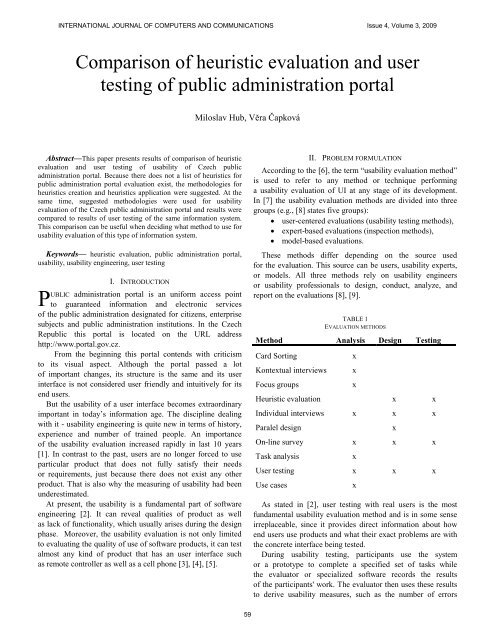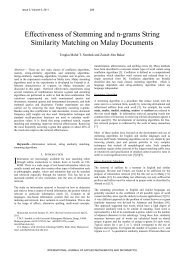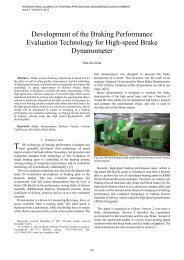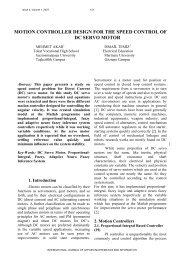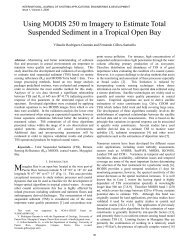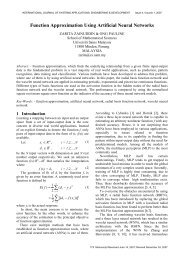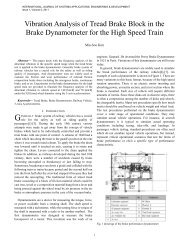Comparison of heuristic evaluation and user ... - university press
Comparison of heuristic evaluation and user ... - university press
Comparison of heuristic evaluation and user ... - university press
You also want an ePaper? Increase the reach of your titles
YUMPU automatically turns print PDFs into web optimized ePapers that Google loves.
INTERNATIONAL JOURNAL OF COMPUTERS AND COMMUNICATIONS Issue 4, Volume 3, 2009<strong>Comparison</strong> <strong>of</strong> <strong>heuristic</strong> <strong>evaluation</strong> <strong>and</strong> <strong>user</strong>testing <strong>of</strong> public administration portalMiloslav Hub, Věra ČapkováAbstract—This paper presents results <strong>of</strong> comparison <strong>of</strong> <strong>heuristic</strong><strong>evaluation</strong> <strong>and</strong> <strong>user</strong> testing <strong>of</strong> usability <strong>of</strong> Czech publicadministration portal. Because there does not a list <strong>of</strong> <strong>heuristic</strong>s forpublic administration portal <strong>evaluation</strong> exist, the methodologies for<strong>heuristic</strong>s creation <strong>and</strong> <strong>heuristic</strong>s application were suggested. At thesame time, suggested methodologies were used for usability<strong>evaluation</strong> <strong>of</strong> the Czech public administration portal <strong>and</strong> results werecompared to results <strong>of</strong> <strong>user</strong> testing <strong>of</strong> the same information system.This comparison can be useful when deciding what method to use forusability <strong>evaluation</strong> <strong>of</strong> this type <strong>of</strong> information system.Keywords— <strong>heuristic</strong> <strong>evaluation</strong>, public administration portal,usability, usability engineering, <strong>user</strong> testingPI. INTRODUCTIONUBLIC administration portal is an uniform access pointto guaranteed information <strong>and</strong> electronic services<strong>of</strong> the public administration designated for citizens, enterprisesubjects <strong>and</strong> public administration institutions. In the CzechRepublic this portal is located on the URL addresshttp://www.portal.gov.cz.From the beginning this portal contends with criticismto its visual aspect. Although the portal passed a lot<strong>of</strong> important changes, its structure is the same <strong>and</strong> its <strong>user</strong>interface is not considered <strong>user</strong> friendly <strong>and</strong> intuitively for itsend <strong>user</strong>s.But the usability <strong>of</strong> a <strong>user</strong> interface becomes extraordinaryimportant in today’s information age. The discipline dealingwith it - usability engineering is quite new in terms <strong>of</strong> history,experience <strong>and</strong> number <strong>of</strong> trained people. An importance<strong>of</strong> the usability <strong>evaluation</strong> increased rapidly in last 10 years[1]. In contrast to the past, <strong>user</strong>s are no longer forced to useparticular product that does not fully satisfy their needsor requirements, just because there does not exist any otherproduct. That is also why the measuring <strong>of</strong> usability had beenunderestimated.At present, the usability is a fundamental part <strong>of</strong> s<strong>of</strong>twareengineering [2]. It can reveal qualities <strong>of</strong> product as wellas lack <strong>of</strong> functionality, which usually arises during the designphase. Moreover, the usability <strong>evaluation</strong> is not only limitedto evaluating the quality <strong>of</strong> use <strong>of</strong> s<strong>of</strong>tware products, it can testalmost any kind <strong>of</strong> product that has an <strong>user</strong> interface suchas remote controller as well as a cell phone [3], [4], [5].II. PROBLEM FORMULATIONAccording to the [6], the term “usability <strong>evaluation</strong> method”is used to refer to any method or technique performinga usability <strong>evaluation</strong> <strong>of</strong> UI at any stage <strong>of</strong> its development.In [7] the usability <strong>evaluation</strong> methods are divided into threegroups (e.g., [8] states five groups):• <strong>user</strong>-centered <strong>evaluation</strong>s (usability testing methods),• expert-based <strong>evaluation</strong>s (inspection methods),• model-based <strong>evaluation</strong>s.These methods differ depending on the source usedfor the <strong>evaluation</strong>. This source can be <strong>user</strong>s, usability experts,or models. All three methods rely on usability engineersor usability pr<strong>of</strong>essionals to design, conduct, analyze, <strong>and</strong>report on the <strong>evaluation</strong>s [8], [9].TABLE 1EVALUATION METHODSMethod Analysis Design TestingCard SortingKontextual interviewsFocus groupsHeuristic <strong>evaluation</strong> x xIndividual interviews x x xParalel designOn-line survey x x xTask analysisUser testing x x xUse casesxxxxxAs stated in [2], <strong>user</strong> testing with real <strong>user</strong>s is the mostfundamental usability <strong>evaluation</strong> method <strong>and</strong> is in some senseirreplaceable, since it provides direct information about howend <strong>user</strong>s use products <strong>and</strong> what their exact problems are withthe concrete interface being tested.During usability testing, participants use the systemor a prototype to complete a specified set <strong>of</strong> tasks whilethe evaluator or specialized s<strong>of</strong>tware records the results<strong>of</strong> the participants' work. The evaluator then uses these resultsto derive usability measures, such as the number <strong>of</strong> errorsx59
INTERNATIONAL JOURNAL OF COMPUTERS AND COMMUNICATIONS Issue 4, Volume 3, 2009<strong>and</strong> task completion time [2], [10]. Nielsen [11] claims thata usability test with five participants will typically reveal 80%<strong>of</strong> the site-level usability problems (e.g., home page,information architecture, navigation, etc.) <strong>and</strong> 50%<strong>of</strong> the page-level problems (e.g., underst<strong>and</strong>ability <strong>of</strong> thenavigation structure).In contrast to <strong>user</strong>-centered <strong>evaluation</strong>s a usabilityinspection consists <strong>of</strong> <strong>evaluation</strong> methods wherebyan evaluator examines the usability aspects <strong>of</strong> a UI design witha respect to its conformance to a set <strong>of</strong> guidelines [8].The fundamental goal <strong>of</strong> all inspection methods is to findusability problems in an existing interface design <strong>and</strong> then usethese problems to make recommendations for improvingthe usability <strong>of</strong> an interface [2].Guidelines can range from highly specific recommendationsto broad principles. Unlike the other usability <strong>evaluation</strong>methods, inspection methods fully rely on evaluator’sjudgment. A large number <strong>of</strong> detailed usability guidelines havebeen developed for web interfaces, some <strong>of</strong> them can be foundfor instance in [2], [12], [17].Commonly used inspection techniques are <strong>heuristic</strong><strong>evaluation</strong> [2] <strong>and</strong> cognitive walkthroughs [13]. The former isconsidered easy to learn, while the latter is considered neitheras easy to learn nor easy to apply [14].In <strong>heuristic</strong> <strong>evaluation</strong>, one or more evaluatorsindependently evaluate an interface using a list <strong>of</strong> <strong>heuristic</strong>s.After evaluating the interface, the evaluators aggregate theirfindings <strong>and</strong> associate severity ratings with each potentialusability problem. The output <strong>of</strong> this <strong>evaluation</strong> is typicallya list <strong>of</strong> possible usability problems [2].A <strong>heuristic</strong> <strong>evaluation</strong> is the most informal inspectionmethod [14], mainly because it relies on a small set <strong>of</strong> usabilitycriteria. Since the <strong>heuristic</strong> <strong>evaluation</strong> is very cheap, fast<strong>and</strong> easy-to-use [14], it is therefore the most widely usedinspection method [7].Studies as [14] have also shown that the simplerthe technique, the more effective the method is for identifyingusability problems.TABLE 2COMPARISON OF HEURISTIC EVALUATION AND USER TESTINGActually, the most used usability <strong>evaluation</strong> methods arethe <strong>user</strong> testing <strong>and</strong> <strong>heuristic</strong> <strong>evaluation</strong>. These methods haveboth advantages <strong>and</strong> disadvantages that are shown in the table2. The <strong>heuristic</strong> <strong>evaluation</strong> appears favorable for cheap <strong>and</strong>quick finding <strong>of</strong> the most significant usability faults<strong>of</strong> an existing <strong>user</strong> interface.Although some defined sets <strong>of</strong> <strong>heuristic</strong> criteria exist,there does not a formulated methodology <strong>of</strong> <strong>heuristic</strong> criteriacreating exist. Existing criteria are <strong>of</strong>ten overly general<strong>and</strong> cover only common types <strong>of</strong> s<strong>of</strong>tware interfaces.Sometimes a necessity to have a <strong>heuristic</strong>s set availablefor the <strong>heuristic</strong> <strong>evaluation</strong> <strong>of</strong> nonst<strong>and</strong>ard s<strong>of</strong>tware canemerge.Therefore, the goal <strong>of</strong> this paper is to suggesta methodology for <strong>heuristic</strong>s creation <strong>and</strong> <strong>heuristic</strong>sapplication for a <strong>heuristic</strong> <strong>evaluation</strong> <strong>of</strong> usability aspect<strong>of</strong> given <strong>user</strong> interface.The requirements to the suggested methodology are:• Systematic character (individual activities <strong>of</strong> themethodology have to be systematically organized)• Simplification (simplified <strong>and</strong> illustrative description<strong>of</strong> a solved situation)• Homogeneity (all parts <strong>of</strong> the methodology have to besuggested in the same manner)• Measurability (parameterization <strong>and</strong> measurability<strong>of</strong> facts)• Objectivity (objectivity <strong>of</strong> methodology results)• Unambiguity (exact definition <strong>of</strong> all activities)Except it, this methodology will be applied for a case study– <strong>heuristic</strong> <strong>evaluation</strong> <strong>of</strong> the Czech public administrationportal.III. METHODOLOGY OF HEURISTICS CREATIONA. Model <strong>of</strong> <strong>heuristic</strong>s creationThe goal <strong>of</strong> this methodology is to create a suitable set<strong>of</strong> <strong>heuristic</strong> criteria that can be used for the usability<strong>evaluation</strong> <strong>of</strong> given information system – the Czech publicadministration portal in this case. The suggested steps<strong>of</strong> this methodology are shown on the Fig. 2.60
INTERNATIONAL JOURNAL OF COMPUTERS AND COMMUNICATIONS Issue 4, Volume 3, 2009E. Preparation <strong>of</strong> <strong>heuristic</strong>s creationThis phase includes activities necessary for resourcesacquiring, especially personal resources. This phase consists<strong>of</strong> these 6 steps:1. Choice <strong>of</strong> a project manager2. Choice <strong>of</strong> a main usability expert3. Training <strong>of</strong> a main usability expert4. Project teams forming5. Training <strong>of</strong> project team members6. Assignment <strong>of</strong> a workplace <strong>and</strong> equipmentF. Heuristics creationDuring this critical phase the project team 1 selects,categorizes, adds <strong>and</strong> modifies the basic set <strong>of</strong> <strong>heuristic</strong>s. Thisphase consists <strong>of</strong> four steps:1. Choice <strong>of</strong> a scale for the <strong>heuristic</strong>s importance rating2. Definition <strong>of</strong> thematic <strong>heuristic</strong> categories3. Assignment <strong>of</strong> <strong>heuristic</strong>s to defined <strong>heuristic</strong>categories4. Modification <strong>of</strong> <strong>heuristic</strong> setsFig. 1 Model <strong>of</strong> <strong>heuristic</strong>s creationB. Basic set <strong>of</strong> <strong>heuristic</strong>sInputs to the suggested model are existing sets <strong>of</strong> known<strong>heuristic</strong>s published by practitioners for different types<strong>of</strong> <strong>user</strong> interface. Simultaneously own <strong>heuristic</strong>s basedon previous experiences with given information system canbe added.C. Specification <strong>of</strong> requirements on resourcesFour working roles are necessary for the <strong>heuristic</strong>screation:• Project manager – project coordination,administration, training, communication with the mainexpert.• Main usability expert – supervision, <strong>heuristic</strong>saddition, validation <strong>of</strong> the result set <strong>of</strong> <strong>heuristic</strong>s,assessment <strong>of</strong> accordance <strong>of</strong> the <strong>user</strong> <strong>and</strong> expert<strong>evaluation</strong> <strong>of</strong> <strong>heuristic</strong>s.• Member <strong>of</strong> project team 1– a usability expert,creation <strong>and</strong> modification <strong>of</strong> the basic set<strong>of</strong> <strong>heuristic</strong>s, <strong>evaluation</strong> <strong>of</strong> the suggested set<strong>of</strong> <strong>heuristic</strong>s.• Member <strong>of</strong> project team 2 – an end <strong>user</strong>, <strong>evaluation</strong><strong>of</strong> the suggested set <strong>of</strong> <strong>heuristic</strong>s.The recommended number <strong>of</strong> team 1 <strong>and</strong> team 2members is from 3 to 5 [13].D. Environment analysisAn environment analysis consists <strong>of</strong> familiarizing withthe concrete type <strong>of</strong> <strong>user</strong> interface <strong>and</strong> its specificity. It isnecessary to familiarize with the basic functionality <strong>of</strong> system,end <strong>user</strong>s <strong>and</strong> given environment where the system is used.As a scale for the <strong>heuristic</strong>s importance rating we suggestthe five-degree scale (1 - not important, 2 - less important, 3 -medium important, 4 - important, 5 - highly important).As an inspiration for the <strong>heuristic</strong>s categories defining canbe Nielsen [7] that suggests 10 categories like an aesthetics<strong>and</strong> minimalist design, help <strong>and</strong> documentation, visibility<strong>of</strong> the system status <strong>and</strong> so on.An assignment <strong>of</strong> <strong>heuristic</strong>s to <strong>heuristic</strong> categoriesis executed by the project team 1 with help by focus groupmethod. Basic <strong>heuristic</strong>s can be modified <strong>and</strong> added at thisphase.The set <strong>of</strong> <strong>heuristic</strong>s is adjusted by project team 1on the base <strong>of</strong> the following rules:• Heuristic criterion has to fit to a categoryfor the target system.• Heuristic criterion has not be duplicate with othercriterion.• Heuristic criterion has to be defined clearly<strong>and</strong> simply.G. Evaluation <strong>of</strong> <strong>heuristic</strong>sThe result <strong>of</strong> this phase is a final set <strong>of</strong> <strong>heuristic</strong>s. Thisphase consists <strong>of</strong> three steps:1. Evaluation <strong>of</strong> <strong>heuristic</strong>s from the importance point<strong>of</strong> view.2. Aggregation <strong>of</strong> values for both project teams.3. Assessment <strong>of</strong> the rate <strong>of</strong> correspondence betweenboth project teams.The <strong>evaluation</strong> <strong>of</strong> <strong>heuristic</strong>s is carried out both by projectteam 1 <strong>and</strong> project team 2. The goal is to get a perspectivefrom both an expert <strong>and</strong> real <strong>user</strong> point <strong>of</strong> view. Every teammember gets a list <strong>of</strong> <strong>heuristic</strong>s <strong>and</strong> evaluates <strong>heuristic</strong>s fromimportance point <strong>of</strong> view.The goal <strong>of</strong> the third step is to exclude criteria that bothproject teams assessed overly differently <strong>and</strong> exclude criteriathat are not so important.61
INTERNATIONAL JOURNAL OF COMPUTERS AND COMMUNICATIONS Issue 4, Volume 3, 2009IV. METHODOLOGY OF HEURISTICS APPLICATIONA. Model <strong>of</strong> <strong>heuristic</strong>s applicationThe goal <strong>of</strong> the <strong>heuristic</strong>s application methodology isto evaluate the <strong>user</strong> interface <strong>of</strong> given information system fromthe usability point <strong>of</strong> view.This <strong>evaluation</strong> can be useful for different reasons. The firstreason can be a necessity to expose usability problems beforethese problems are solved. The next reason can be necessityto compare different versions <strong>of</strong> a system <strong>and</strong> investigatewhether a new version has usability improvements. Anotherreason can be the possibility to compare two <strong>and</strong> moreproducts from the usability point <strong>of</strong> view.The model <strong>of</strong> this methodology is shown on the 2.D. Preparation phasePreparation phase consists <strong>of</strong> two steps:1. Project team creation2. Suggesting <strong>of</strong> <strong>heuristic</strong> seriousness scaleAs <strong>heuristic</strong> seriousness scale we suggest the followingscale:0- I do not agree that it presents a usability problem.1- It is a cosmetic problem only.2- It is a problem with less importance, solving it has a lowpriority.3- It is an important usability problem with high priority<strong>of</strong> the solving.4- It is a critical usability problem, it is necessary to solve itbefore the system is switched up.E. Evaluation phaseEvaluation phase consists <strong>of</strong> two steps:1. Training <strong>of</strong> evaluators2. Evaluation <strong>of</strong> the <strong>user</strong> interfaceDuring <strong>evaluation</strong> <strong>of</strong> <strong>user</strong> interface every team member ischecking the <strong>user</strong> interface by the final set <strong>of</strong> <strong>heuristic</strong>s. Whena <strong>heuristic</strong> is not fulfilled, the importance <strong>of</strong> this fault is noted.F. Assessment phaseAssessment phase consists <strong>of</strong> three steps:1. Data processing2. Evaluation <strong>of</strong> found usability lacksG. Found usability imperfectionsThe outputs are found usability lacks. The suggestion<strong>of</strong> the problem solving can be attached to the usability testingreport.V. CASE STUDY: HEURISTIC EVALUATION OF THE PORTALFig. 2 Model <strong>of</strong> <strong>heuristic</strong>s applicationB. Final set <strong>of</strong> <strong>heuristic</strong>sThe input to this model is a final set <strong>of</strong> <strong>heuristic</strong>s createdwith help <strong>of</strong> the methodology <strong>of</strong> <strong>heuristic</strong>s creation.C. Specification <strong>of</strong> requirements on resourcesThree working roles are necessary for <strong>heuristic</strong>sapplication:• Project manager – project coordination,administration.• Main usability expert – preparation <strong>of</strong> <strong>heuristic</strong><strong>evaluation</strong>, managing <strong>of</strong> <strong>evaluation</strong>, data processing,formulation <strong>of</strong> results.• Project team – <strong>evaluation</strong> <strong>of</strong> a <strong>user</strong> interface by the set<strong>of</strong> <strong>heuristic</strong>s.A. Heuristics creationAs a case study <strong>of</strong> <strong>heuristic</strong> <strong>evaluation</strong> a usability <strong>evaluation</strong><strong>of</strong> the Czech public administration portal was chosen.A <strong>heuristic</strong> list suggested by University <strong>of</strong> Minnesota Dulth[14] was used as the input to our methodology. This setcontains extensive list <strong>of</strong> <strong>heuristic</strong>s divided to ten thematiccategories. At the same time <strong>heuristic</strong>s from the next resources[7], [10] were added to this list.An analysis <strong>of</strong> the public administration portal showed thata graphic aspect <strong>of</strong> this portal is not compact <strong>and</strong> consistentthrough different sections <strong>of</strong> this web (the <strong>user</strong> interface <strong>of</strong> theportal is shown on the Fig. 3).62
INTERNATIONAL JOURNAL OF COMPUTERS AND COMMUNICATIONS Issue 4, Volume 3, 2009for a <strong>heuristic</strong> <strong>evaluation</strong> <strong>of</strong> the public administration portal.These <strong>heuristic</strong>s were divided to seven areas <strong>of</strong> usabilityaspects like an esthetics, help, documentation, <strong>and</strong> so on.Fig. 3 Czech public administration portalFor example, the section “Maps” is built as an independentgeographic information system with a different <strong>user</strong> interface(see Fig. 4). Therefore this section should be evaluated bya different set <strong>of</strong> <strong>heuristic</strong>s <strong>and</strong> should be evaluated separately.B. Heuristics applicationOur <strong>evaluation</strong> team consisted <strong>of</strong> three experts – two<strong>of</strong> them were usability specialists <strong>and</strong> one was a webpagespecialist. It was decided that the five degree scale would beused – the same scale like Nielsen published in his work [10].Because a member <strong>of</strong> <strong>evaluation</strong> team was a non usabilityspecialist, usability training was carried out. The part <strong>of</strong> thistraining was presentation <strong>of</strong> basic principles <strong>of</strong> the <strong>heuristic</strong><strong>evaluation</strong>. Trainees were familiarized with the <strong>user</strong> interface<strong>of</strong> the public administration portal as well.During <strong>evaluation</strong> the evaluators filled a form by “yes”or “no” answers. The answer “no” means that the <strong>heuristic</strong>criterion was not met. Simultaneously, evaluators filledseriousness degree <strong>of</strong> exposed issues – <strong>heuristic</strong>s where the“no” was filled. The acquired data were than aggregated.In total, 30 <strong>heuristic</strong>s from 92 were not fulfilled.This <strong>heuristic</strong>s were divided according the level <strong>of</strong> seriousness(see the table 2).TABLE 2NUMBERS OF NOT FULFILLED HEURISTICSFig. 4 Maps section on Czech public administration portalFor the <strong>heuristic</strong>s creation two teams were created. The firstteam was represented by a usability expert, IT expert <strong>and</strong>webpage specialist. The second team was represented by threeend <strong>user</strong>s <strong>of</strong> the portal.As <strong>heuristic</strong>s thematic sets were defined:• Visibility <strong>of</strong> system status• Correspondence <strong>of</strong> system with real world• User control <strong>and</strong> freedom• Consistency <strong>and</strong> st<strong>and</strong>ards• Esthetic <strong>and</strong> minimalist design• Help <strong>and</strong> documentation• PrivacyNext categories were not used because they are suitablefor desktop applications only.By this methodology 92 <strong>heuristic</strong> criteria were selectedVI. RESULTS OF HEURISTIC EVALUATIONFor the lack <strong>of</strong> space only critical found usability problems(<strong>heuristic</strong> violations) are presented in this paper:1. Is a firm logo simultaneously a link to the homepage?The logo picture <strong>of</strong> the portal is not a linkto the homepage.2. Is the URL meaningful <strong>and</strong> pleasant?The URL address http://www.portal.gov.cz is hardto remember for end <strong>user</strong>s.3. Is the font size <strong>and</strong> font type suitable for easy reading?The text is cramped <strong>and</strong> font is very small for reading.4. Are visited <strong>and</strong> not visited web pages visuallydistinguished?The highlighting <strong>of</strong> visited links is forbiddenat the server.5. Is it easy to return to the homepage by one click?Some pages do not have a direct link to the homepage.6. Is it easy to get to all main pages from the homepage?The link to the transaction part <strong>of</strong> the portal is not easyto find.7. Is it possible to expect consequence <strong>of</strong> every activity(for example a click to the link)?Hypertext links to outside web pages are not graphicallyhighlighted.63
INTERNATIONAL JOURNAL OF COMPUTERS AND COMMUNICATIONS Issue 4, Volume 3, 20098. Is behavior <strong>of</strong> web pages as it is expected?Some pages have inhomogeneous view with differentmenu types.9. Are items in the main menu same through all system?Some portal parts (maps, transaction part) have differentmenu position <strong>and</strong> menu items.10. Are conventions met (for example underlined text usedonly for hyperlinks)?It is not easy to recognize a link to outside web pages.11. Is a structure <strong>of</strong> web pages simple <strong>and</strong> clear withoutuseless complications?The structure <strong>of</strong> the portal is very complicated by highamount <strong>of</strong> links to outside web pages. Some parts <strong>of</strong> weblook differently.VII. USER TESTING OF THE PORTALUser testing <strong>of</strong> Czech public administration portal wasconducted in 2007. Because <strong>user</strong> interface <strong>of</strong> this portal hasnot changed yet, the results <strong>of</strong> this experiment are still valid.Execution <strong>of</strong> this experiment is possible divide to four steps:1. Scenario creation2. Choice <strong>of</strong> participants.3. Usability testing realization4. Evaluation <strong>of</strong> testing, found usability deficienciesChosen participants had to fulfill four tasks in the usabilitylab (see fig. 5):1. Find out address <strong>of</strong> financial authority in Pardubice2. Find out who has right for housing benefit.3. Found out the living minimum in 2007.4. Find out the maximum number <strong>of</strong> overtime hours peryear.Fig. 5 Usability labFive participants were chosen for the experiment:• Payroll accountant, secondary school, female, 48 yearsold, specialist in social benefits, she works every daywith internet.• Call center operator, secondary school, female, 23years old, she uses a computer every day, but internetonly from time to time.• University student, Faculty <strong>of</strong> Economics <strong>and</strong>Administration, female, 23 years old, she every dayuses internet as an information source.• Pensioner, secondary school, male, 65 years old,specialist in technology engineering, he uses acomputer every day, but internet only from time totime.• Network administrator, secondary school, male, 25years old, he is a computers expert <strong>and</strong> he usesinternet every day.The reason for non-homogenous participant selectionis a fact that public administration portals should be intendedfor broad spectrum <strong>of</strong> end <strong>user</strong>s. That is why this sample<strong>of</strong> end <strong>user</strong>s was chosen.User testing <strong>of</strong> the public administration portal uncovered alot <strong>of</strong> usability lacks. The most important usability lacks thatwere uncovered are in following areas:• Homepage – im<strong>press</strong>es chaotically because there is alot <strong>of</strong> information written by a very small font.• Main menu – this menu is not well-marked <strong>and</strong>majority <strong>of</strong> end <strong>user</strong>s do not notice it.• Life situations – left menu is overly extensive, it isdifficult to orientate here. Search results are notclearly arranged <strong>and</strong> they are not sorted by relevance.• Laws – not clearly arranged presentation <strong>of</strong> individuallaws, difficult searching, <strong>and</strong> difficult orientation inthe individual laws.• Searching – Results <strong>of</strong> searching are not sortedby relevance.VIII. COMPARISON OF HEURISTIC EVALUATION AND USERTESTING OF THE PORTALJust as the <strong>heuristic</strong> <strong>evaluation</strong> the <strong>user</strong> testing also showedthat the homepage is very chaotic <strong>and</strong> confusing. Users havea hard time by underst<strong>and</strong>ing the big amount <strong>of</strong> references,which, moreover, are not distinguished. So you do not knowwhich links was already clicked on <strong>and</strong> which was not.In addition there are three types <strong>of</strong> news on the main page -news from the public administration, required disclosures <strong>and</strong>news from portal.gov.cz. While the first two sections areupdated <strong>of</strong>ten new reports on the portal are emerging everycouple <strong>of</strong> months, sometimes for half a year. For this reason,there are quite unnecessary <strong>and</strong> should be moved.Others problems identified by <strong>user</strong> testing are focuseddirectly on end <strong>user</strong>s, therefore, there was not possible to findby a <strong>heuristic</strong> <strong>evaluation</strong>. This is a classic example where it isbetter to perform both types <strong>of</strong> usability <strong>evaluation</strong> methods,because by combination <strong>of</strong> these methods it is possible to find64
INTERNATIONAL JOURNAL OF COMPUTERS AND COMMUNICATIONS Issue 4, Volume 3, 2009wide range <strong>of</strong> problems encountered in graphic design,<strong>and</strong> in a logical grouping <strong>of</strong> web functionality. If these testswere conducted at the design stage <strong>of</strong> portal development,unnecessary errors, which are also present seven years after itsintroduction would be avoided. As it turned out, the <strong>heuristic</strong><strong>evaluation</strong> for usability <strong>evaluation</strong> <strong>of</strong> public administrationportal is more beneficial than <strong>user</strong> testing. By <strong>heuristic</strong><strong>evaluation</strong> it was found more usability faults resulting in totalconfusion <strong>of</strong> public administration portal.IX. BENEFITS OF USABILITY IMPROVEMENTSEconomic <strong>evaluation</strong> <strong>of</strong> usability activities is importantfor two reasons, for demonstration <strong>of</strong> importance <strong>of</strong> usabilityengineering (for the cases when an organization has notintegrated usability in its development process) <strong>and</strong>for effective usability engineering program planning (for thecases when an organization is mature in the sense<strong>of</strong> implementing <strong>of</strong> usability engineering).When conducting economic analysis it is necessaryto consider that the main objective <strong>of</strong> public administrationinstitutes is not a revenue but <strong>of</strong>fering <strong>of</strong> quality publicservices. Therefore it is necessary to consider intangiblebenefits as well. For example increase trust in publicadministration can lead to rising st<strong>and</strong>ard <strong>of</strong> living<strong>of</strong> inhabitant <strong>and</strong> it can results in social repose.It is possible to mention the most important benefits<strong>of</strong> potential usability improvements <strong>of</strong> public administrationportal:- Reduction <strong>of</strong> <strong>user</strong> errors, increase success rate.- Decrease support costs – well designed electronic formsdo not need calls to an <strong>of</strong>fice.- Decrease cost <strong>of</strong> traditional customer service channels –website has relatively low operating costs comparedwith more traditional channels for service distribution.- More leisure time as a result <strong>of</strong> productivity increasing –Users can save a time they would spent on non-usability<strong>user</strong> interface.- Increase a <strong>user</strong> satisfaction.- Increase trust in the system.- Increase trust in the public administration.- Learning increase – it is not easily possible to train end<strong>user</strong>s. Besides, the end <strong>user</strong>s do not <strong>of</strong>ten consumethe same services <strong>of</strong> public administration. End <strong>user</strong>sare not readily accessible, <strong>and</strong> may not be known at all.Therefore end <strong>user</strong> interface must be extremelyintuitive.- Security increase – usability tends to minimization <strong>of</strong> <strong>user</strong>errors that can result in security risk for wholeinformation system.X. CONCLUSIONIn this paper a methodology <strong>of</strong> <strong>heuristic</strong>s creation <strong>and</strong><strong>heuristic</strong>s application is suggested. Suggested methodologyis applied to public administration portal <strong>and</strong> compared to <strong>user</strong>testing. Generally, it is better to perform both types <strong>of</strong> usability<strong>evaluation</strong> methods, because by combination <strong>of</strong> these methodsit is possible to find wide range <strong>of</strong> problems encounteredin graphic design, <strong>and</strong> in a logical grouping <strong>of</strong> webfunctionality.Up to now, <strong>heuristic</strong> criteria sets were defined only on thebase <strong>of</strong> pr<strong>of</strong>essional experiences <strong>of</strong> usability experts. Severallists <strong>of</strong> recommended <strong>heuristic</strong>s defined by leading usabilityexperts exist, but these lists are designated for common types<strong>of</strong> web pages or desktop applications. We are sure <strong>of</strong> necessity<strong>of</strong> wide applicable methodology that can be used for <strong>heuristic</strong>s<strong>evaluation</strong> <strong>of</strong> non st<strong>and</strong>ard <strong>user</strong> interface. Thereforewe suggested that methodology <strong>and</strong> validated it when theCzech public administration portal was evaluated from theusability point <strong>of</strong> view.Further, we created the set <strong>of</strong> <strong>heuristic</strong>s concentratedto public administration portal. These <strong>heuristic</strong>s can be usedwhen different portals or different versions <strong>of</strong> the portal arecompared.In addition, we investigated the Czech public administrationportal <strong>and</strong> found some imperfections in its <strong>user</strong> interfacedesign. Elimination <strong>of</strong> this usability faults can indisputablyyield important benefits. We suggest repeat this usability<strong>evaluation</strong> after important changes in the <strong>user</strong> interface <strong>of</strong> thisportal.ACKNOWLEDGMENTThis paper was created with a support <strong>of</strong> the Grant Agency<strong>of</strong> the Czech Republic, grant No. 402/08/P202 with the titleUsability Testing <strong>and</strong> Evaluation <strong>of</strong> Public AdministrationInformation Systems <strong>and</strong> grant agency <strong>of</strong> Ministry <strong>of</strong> Interior<strong>of</strong> the Czech Republic, grant No. VD20062010A06 focusedon research <strong>of</strong> new principles <strong>of</strong> risk management <strong>and</strong> citizensecurity.REFERENCES[1] J. Nielsen, Designing Web Usability: The Practice <strong>of</strong> Simplicity.Thous<strong>and</strong> Oaks: New Riders Publishing, 1999. ISBN 156205810X.[2] J. Nielsen, Usability Engineering. San Francisco: Morgan KaufmannPublishers Inc., 1995. ISBN 0125184069.[3] A. Kaharoca, et al. “Usability Evaluation <strong>of</strong> Cell Phone User Interfaces”WSEAS TRANSACTIONS. Issue 8, Volume 3, 2006. pp. 1582-1588.ISSN 1709-0832.[4] R. Myšková. Company Information Systems Used in Decision-MakingProcesses <strong>of</strong> Financial Managers. In WSEAS TRANSACTIONS onSYSTEMS. Issue 4, Volume 8, April 2009. p. 532 – 542. ISSN: 1109-2777.[5] T. Arh, B. J. Blazic. A Case Study <strong>of</strong> Usability Testing – the SUMIEvaluation Approach <strong>of</strong> the EducaNext Portal. In WSEASTRANSACTIONS on INFORMATION SCIENCE & APPLICATIONS.Issue 2, Volume 5, February 2008. p. 175 – 181. ISSN: 1790-0832.[6] W. D. Gray, M. C. Salzman, “Damaged Merch<strong>and</strong>ise? A Review<strong>of</strong> Experiments that Compare Usability Evaluation Methods”, Human-Computer Interaction. 1998, Vol. 13, 3, pp. 203-261.[7] J. Scholtz, “Usability <strong>evaluation</strong>”, [ed.] P. Flanagan. Gaithersburg,USA: IAD National Institute <strong>of</strong> St<strong>and</strong>ards <strong>and</strong> Technology, 2004,Encyclopedia <strong>of</strong> Human-Computer Interaction.[8] M. Y. Ivory, An Empirical Foundation for Automated Web InterfaceEvaluation. UC Berkeley Computer Science Division. 2001. Ph.D.Dissertation.65
INTERNATIONAL JOURNAL OF COMPUTERS AND COMMUNICATIONS Issue 4, Volume 3, 2009[9] J. Komarkova, et al., “Usability <strong>of</strong> GeoWeb Sites: Case Study <strong>of</strong>Czech Regional Authorities Web Sites”, Lecture Notes in ComputerScience, 2007, vol. 4439, pp. 411-423. ISSN 0302-974.[10] B. Shneiderman, C. Plaisant, Designing the User Interface: Strategiesfor Effective Human-Computer Interaction. The 4th edition. New York:Addison Wesley, 2004. ISBN 0321197860.[11] J. Nielsen, Designing Web Usability: The Practice <strong>of</strong> Simplicity.Thous<strong>and</strong> Oaks: New Riders Publishing, 1999. ISBN 156205810X.[12] P. Lynch, S. Horton, Web Style Guide: Basic Design Principles forCreating Web Sites. The 6th edition. New Haven: Yale University Press,1999. ISBN 0300076754.[13] C. Lewis, et al. ”Testing a walkthrough methodology for theory-baseddesign <strong>of</strong> walk-up-<strong>and</strong>-use interfaces”, Proceedings <strong>of</strong> the Conferenceon Human Factors in Computing Systems. Seattle: ACM Press, 1990.pp. 235-242.[14] J. Nielsen, R. L. Mack, Usability Inspection Methods. New York:Wiley, 1994. ISBN 0471018775.[15] J. Nielsen, Useit.com [online]. 2005. How to Conduct a HeuristicEvaluation. Available: .[16] University <strong>of</strong> Minnesota Duluth : Information Technology Systems& Services [online]. 2010. General Usability Checklist. Available:.[17] J. Komárková, P. Sedlák, Pavel, M. Novák, V. Slavíková, A. Musilová.Problems in Usability <strong>of</strong> Web-Based GIS. In DEO, Narsingh, et al.APPLIED COMPUTER SCIENCE: Procedings <strong>of</strong> InternationalConference on Applied Computer Science (ACS). Malta: WSEAS Press,2010. s. 419-425. ISBN: 978978-960-474-225-7, ISSN 1792-4863.66


